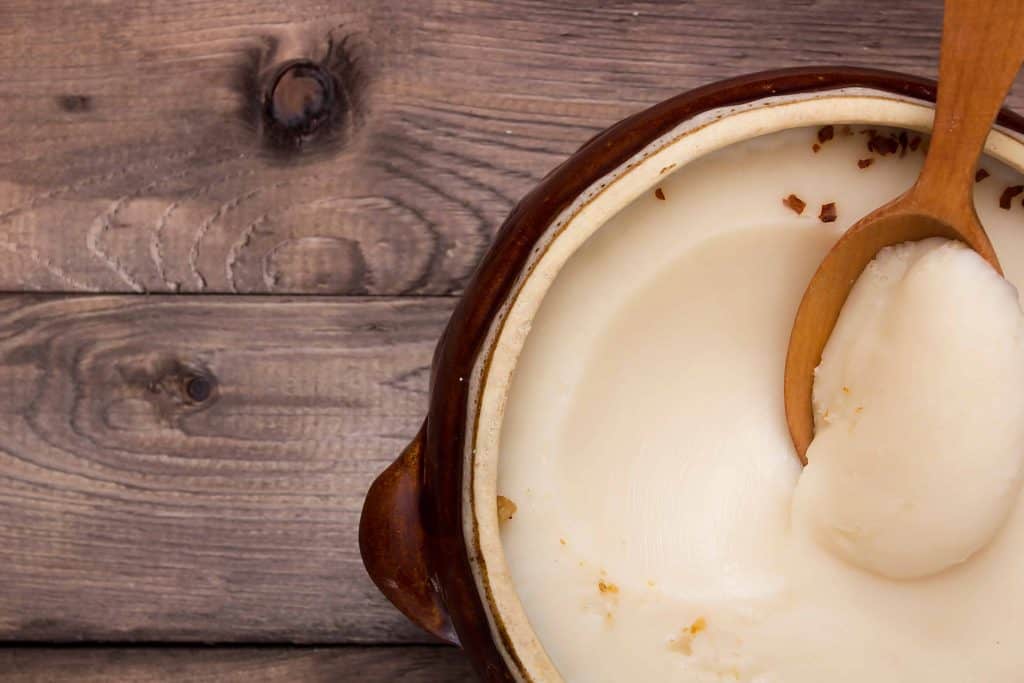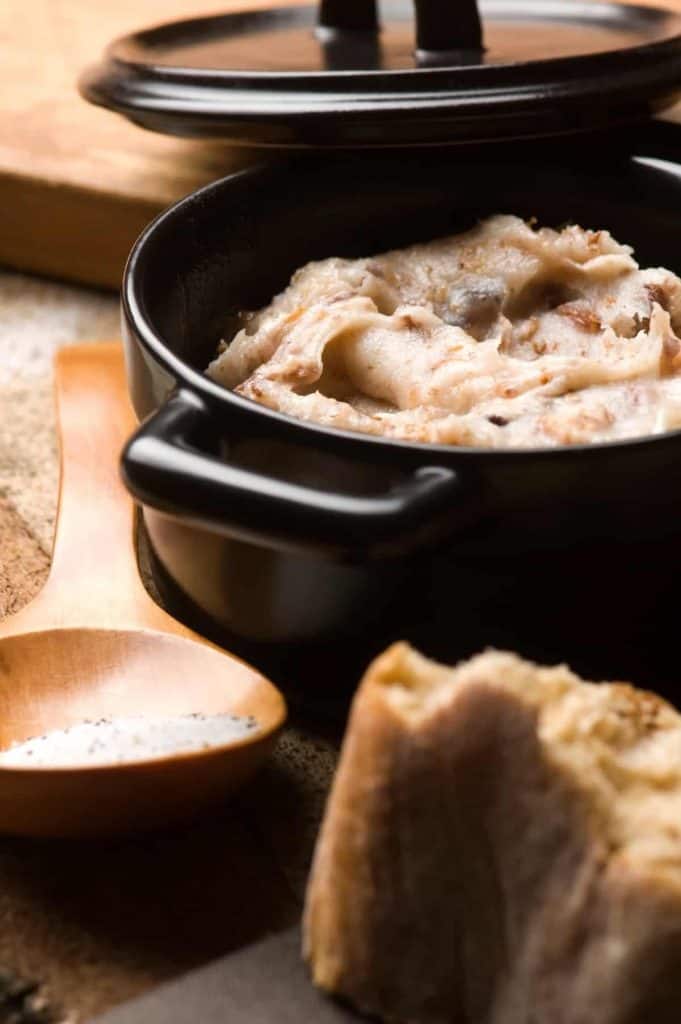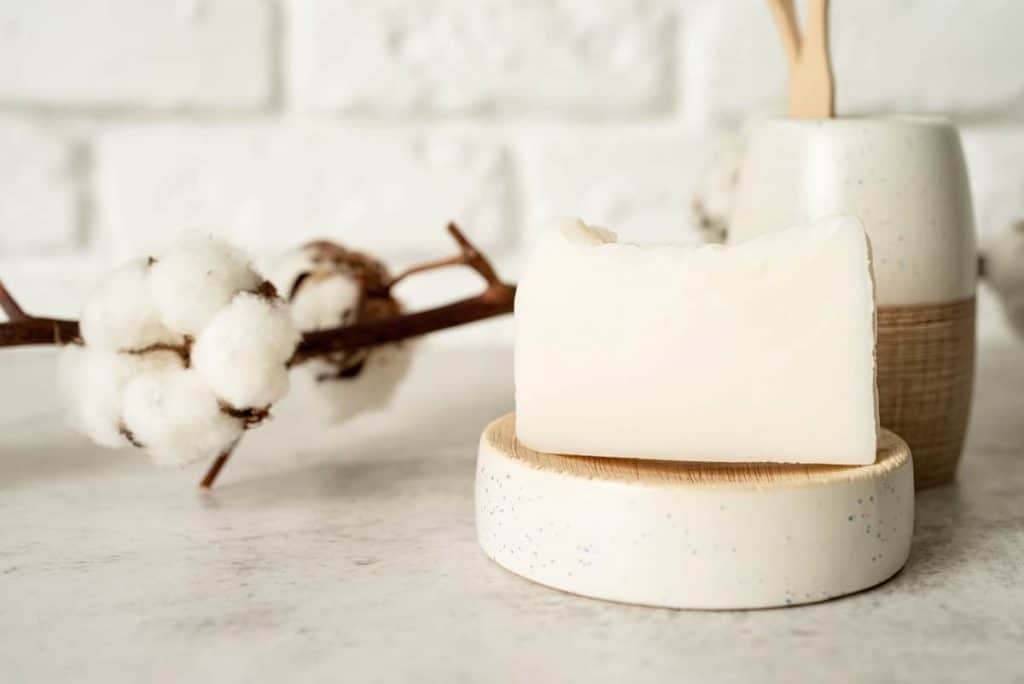What Is Soap With Only Animal Fat Like
RusticWise is supported by its readers. When you purchase through links on our site, nosotros may earn an chapter commission. Equally an Amazon Acquaintance, nosotros earn from qualifying purchases. Cheers!
Whether you raise your own cows or pigs, hunt, or just want to make use of an animal office that's oftentimes thrown away, using animal fat to brand soap is frugal and sustainable. While information technology may sound tricky, learning how to make soap from fauna fat is a traditional practice that involves using merely distilled water, lye, and rendered fat. Beef tallow or hog lard are two mutual types of fats.
Lard or tallow soaps are hard, long lasting, and moisturizing.
Nosotros'll look at the various properties of common animate being fats, and show y'all how to return, and make a simple cold procedure soap recipe using bones ingredients and beef tallow. Plus, we'll likewise share a recipe for a blended lard and vegetable oil lather.
Let's go started!
Why employ brute fat to make soap?
Using animate being drippings or fatty and turning information technology into soap is something homesteaders take been doing for generations.
The applied art of soap making actually goes back further—at least thousands of years. In 600 B.C.E., the ancient Phoenicians made soap from burnt ashes and goat tallow. The Celts also produced soap made of animal fatty and plant ashes; they chosen information technology saipo which is where the modern term soap derives from.¹
At present, learning how to brand lather from animate being fat isn't for anybody. If yous are vegan, or vegetarian, or just plain opposed to using animal products, and then I understand yous won't want to use brute fatty.
However, this dorsum-to-basics approach to making soap using what you have available is a time-tested and reliable way to create good soap. Call it zero-waste living, or self-sustainability if you like.
Rather than throwing away an animal part, you tin can convert information technology to good use and brand something natural and useful for yourself and family unit.
While different fauna fats have unique properties, most produce hard bars of soap with a creamy lather.
What's the departure between lard and tallow?
While people often utilize these terms interchangeably, lard refers to squealer fat, while tallow comes from a variety of grazing animals. Most commonly you'll detect beef tallow, but there'southward also deer tallow, goat tallow, bear tallow, and sheep tallow.
Both lard and tallow make fine bars of soap.

Credit: 123RF.com
Does soap made from animate being fat aroma?
No, properly rendered beast fat will not produce smelly soap. This is one of the most mutual concerns that people take. Rest assured that you won't smell like a slab of salary, or a rib-eye steak after lathering with an creature fat lather!
A properly made lard soap or tallow soap should take a mild aroma. If the idea of animal fat soap still turns you off, you can e'er add some fragrance oils or essential oils to mask the aroma.
Benefits of making soap using animate being fatty
The benefits of making your own soap using animal fat are many.
- Inexpensive: Many vegetable oils, including kokosnoot oil, olive oil, or shea butter, can quickly add up. Using animal fatty from your own animals is the cheapest soap making oil yous tin apply. Even if y'all buy your own rendered lard, information technology's even so toll-constructive if you're watching your pennies.
- Low waste living: I love the thought of not wasting any role of an fauna—information technology shows respect to the animal and to the environs.
- Moisturizing (but not greasy): Lard or tallow soap bars are mild and moisturizing, without leaving the peel feeling greasy. They're great for those with sensitive pare or dry skin.
- Makes proficient, long-lasting bars: Some vegetable oils used in soap making take a shorter shelf life as some oils oxidize quickly. Not and then with lard or tallow soaps. Yous'll discover they produce hard and long-lasting bars of soap with like properties of palm oil.
Where to notice lard or tallow
Some grocery stores sell rendered fatty in tubs or boxes. Yous can also try request a local butcher for leftover fat or trimmings (you lot'll accept to render it of form yourself, which we'll cover below).
You'll also find rendered fatty online at most soap suppliers, and on Amazon.
Of course, if you accept your own animals at domicile (or have a farmer friend), you'll accept access to gratis lard or tallow!
Types of animate being fat and their backdrop in soap
Most animal fats are fine to employ in a one-fat homemade soap recipe (or unmarried-oil lather). Merely the fat from chicken and geese are too soft to apply on their own.
Hither's a look at the various properties of lard and types of tallow in lather. Notice that some are harder than others (a higher number shows more hardness).
Also note that every animal fatty has a unlike SAP value, or saponification number. This means that some types of fat will require more (or less) lye to convert it into soap. The values are dissimilar depending on if you're using sodium hydroxide lye (NaOH), or potassium hydroxide lye (KOH).
It's always a skilful idea to run your numbers through a lye calculator first such equally Soap Calc. (That'southward where I obtained the following numbers.) http://world wide web.soapcalc.cyberspace/calc/soapcalcwp.asp
Table: Animal Fat Properties in Soap
| Squealer Lard | Beef Tallow | Bear Tallow | Deer Tallow | Goat Tallow | Sheep Tallow | |
|---|---|---|---|---|---|---|
| Hardness | 42 | 58 | 12 | 45 | 69 | 51 |
| Cleansing | ane | 8 | 2 | ane | sixteen | 14 |
| Conditioning | 52 | forty | 79 | 48 | 31 | 31 |
| Bubbly lather | ane | 8 | 2 | 1 | 16 | fourteen |
| Creamy lather | 41 | l | 10 | 44 | 53 | 37 |
| NaOH SAP | 0.141 | 0.143 | 0.139 | 0.138 | 0.137 | 0.138 |
| KOH SAP | 0.198 | 0.2 | 0.1946 | 0.193 | 0.192 | 0.194 |
Equally you can see, caprine animal tallow is the "hardest" when used as a unmarried oil, followed by beef tallow, sheep tallow, and squealer lard. Comport tallow is the softest of animal fats listed to a higher place.
An overview on rendering fat
An important role of learning how to brand lather from animal fat involves learning to render fatty. Rendered fat is simply "clean" melted fatty that has been strained of whatever impurities.²
If you've collected fat from your ain animals or a butcher, gear up aside an afternoon to render fatty for soap.

Credit: Yay Images
You'll need:
- A big pot
- Wooden spoon
- Cheesecloth, sieve, or slotted spoon to remove cracklings
- Several glass mason jars or heat-safe containers to store rendered lard
- Cutting board and knife
- Water (for 10 pounds of fat, apply 4 cups of water; for ane pound of fat use slightly less than 1/2 cup of h2o)
- Cut into minor pieces. Gather trimmings and cut into small chunks of fat. This helps speed things up.
- Heat on low. Place pieces of fat into a large pot on the stove. Add water (slightly less than 1/2 cup of water per pound of fat) and heat on low.
- Stir occasionally. Depending on how large your batch is, information technology can have one or two hours to completely melt the fat. Resist the temptation to plough up the heat—this may burn down it.
- Await for cracklings. Cracklings are the small brown pieces that course on the bottom. In one case your fatty is finished rendering, you lot'll see cracklings appear at the lesser.
- Strain and store. Advisedly strain the hot rendered lard or tallow by pouring into a sieve, or using a cheesecloth. It's important to employ heat-proof containers such as bricklayer jars. Continue straining until all cracklings are removed. Allow the rendered fatty to cool before storing.
Your rendered fat should have no (or little) smell. At room temperature, it'll look white and flossy. Store in the fridge until you lot're set up to make soap from scratch.
Read upward on lye safety first
If y'all've never made soap from scratch earlier, please read up on basic soap rubber before you begin.
The type of lye you'll need to utilize is pure sodium hydroxide lye crystals (NOT the stuff with added chemicals!).
Lye is a caustic chemical that can damage skin and eyes. It creates an exothermic reaction when mixed with h2o—information technology can reach temperatures of 200 degrees Fahrenheit (93 degrees Celsius).
When mixed with water, lye releases fumes, which is why you'll desire to work in a well-ventilated area. Wearing protective equipment is also a must. Take hold of a pair of safety goggles, gloves, and article of clothing a long-sleeved shirt.
Use heat-safe and not-reactive utensils and equipment such as stainless steel and silicon, and some types of plastic. Lye reacts strongly with aluminum.
Bank check out an in-depth commodity about basic soap making supplies.
Tips on heating fatty
Before y'all go started, information technology'due south good to notation that there are different ideal temperatures to heat various types of animal fat. Avoid cranking upwards the heat every bit this may fire and darken the color of the finished soap.
| Type of Fat | Temperature (Fahrenheit/Celsius) |
|---|---|
| Vegetable oil | 110–115 °F (43–46 °C) |
| Comport | 115 °F (46 °C) |
| Beef | 130 °F (54 °C) |
| Deer | 130 °F (54 °C) |
| Pork | 120 °F (49 °C) |
| Sheep | 130 °F (54 °C) |

How to make soap from animal fat: step past pace
The following recipe uses the cold process soap making process.
Since we already take an article about making lard soap, this one uses beef tallow.
Pure beef tallow soap recipe
Beef tallow as a single oil makes for a white bar of lather that's hard and long lasting. Information technology won't create a bubbly lather, but it makes a mild, creamy soap with plenty of skin loving moisturizing properties.
This recipe uses five percent superfat.
Yield: Roughly 1½ pounds of soap, or roughly 4 bars of soap
Supplies:
- Digital kitchen scale
- Thermometer (digital, infrared, or candy thermometer)
- Immersion blender (stick blender)
- Stainless steel saucepan for melting the lard
- Heat-safe jug for the lye solution
- Rubber spatula for stirring and scraping
- Loaf mold or individual silicone molds
- Wax paper or piece of cardboard to cover the soap mold
- Old towels to insulate the lather mold
- Safety gear (goggles and gloves)
Ingredients:
Lye solution:
- 6.08 ounces distilled h2o
- 2.17 ounces sodium hydroxide lye
Fatty:
- 16 ounces rendered beefiness tallow
Fragrances:
- Optional: 0.v ounces of your selection of essential oil (lavender essential oil is a popular scent)
- Prepare the lye mixture. Put your safety gear on—it's about to get hot in here! Measure out the distilled water and add to oestrus-safe jug. Measure the sodium hydroxide and slowly add to water (Not the other way around). Allow the lye mixture to cool.
- Mensurate and oestrus tallow in a saucepan. Warm the fat over low rut in a stainless steel saucepan until melted, stirring occasionally.
- Bring to trace. Once the lye mixture has cooled and is of similar temperature to the combined oils, carefully add the lye to the oils. A skilful temperature is somewhere around 110 degrees Fahrenheit (43 degrees Celsius). Use an immersion blender (stick blender) to combine the soap batter until it thickens and turns opaque (reaches trace).
- Add essential oil. Once your lather batter has reached trace, add your essential oil and stir to combine. This stride is optional. Yous tin can get out your bar unscented if you prefer.
- Cascade into mold. Cascade the soap batter into a prepared mold. Cover with wax paper or a piece of cardboard. Wrap some old towels to insulate the lather.
- Fix, cut, and cure. Allow the soap batter to cool and harden (at least 24 hours). If soap has hardened, unmold and cut into bars. If bars are too soft, permit information technology to set for several more days. Let the soap confined cure for 3 to 4 weeks in a well-ventilated room. You'll become a longer lasting bar this way.
Lard, olive oil, and kokosnoot oil recipe
A blend of vegetable oils combined with lard strikes the residuum betwixt workout and cleansing properties. Kokosnoot oil is a highly effective cleanser and creates fluffy lather. A splash of brush oil brings the bubbly soap nearly people dearest in a soap bar.
The following common cold process recipe is from Alicia Grosso's The Everything Soapmaking Book.
Yield: Roughly 1½ pounds of soap, or roughly 4 bars of soap
Ingredients:
Lye solution:
- five ounces distilled water (172.36 grams)
- 2.3 ounces sodium hydroxide lye
Difficult oils/fats:
- 5 ounces lard
- 5 ounces coconut oil
Soft oils:
- vi ounces olive oil
- 0.5 ounces castor oil
Directions: Follow the same cold process steps as the pure tallow recipe above. In Step 2, melt the lard and coconut oil first earlier combining with the soft oils.
New to making soap? 🧼❓

References
- Britannica, Soap, Soap, https://world wide web.britannica.com/scientific discipline/lather. Accessed Jan 2022.
- Emery, Carla (2012). The Encyclopedia of Country Living, 40th Anniversary Edition. Sasquatch Books. pp. 635–637. ISBN-13: 978-ane-57061-840-half dozen.
- Grosso, Alicia (2013). The Everything Soapmaking Book, 3rd Edition. Adams Media. pp. 90. ISBN 13: 978-1-4405-5013-three.

Source: https://rusticwise.com/how-to-make-soap-from-animal-fat/
Posted by: penaectilow.blogspot.com

0 Response to "What Is Soap With Only Animal Fat Like"
Post a Comment